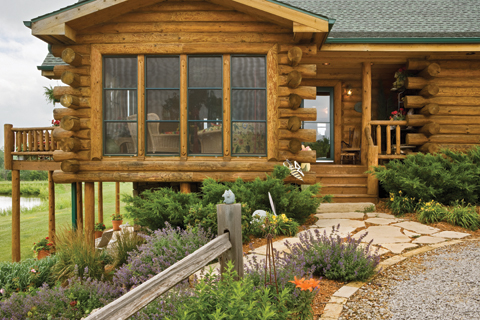Low-maintenance, long-lasting good looks, environmental friendliness, and reasonable cost are just some of the elements that factor into choosing the right log home exterior finish. Evaluating the available options may be a challenge, but an understanding of the basics helps ease the process and produce the desired results.
Paul Peebles, a commercial sales representative at Perma-Chink Systems, agrees that appearance, longevity, value, and environmental considerations top the list. “In addition to building a quality home, you want to build a beautiful home,” he comments, “which is why the finished appearance of your logs is so important. By spending a little bit up front, you’ll get a distinguished-looking wood finish that will set your home apart from the rest.”
According to Perma-Chink President Rich Dunston, furniture grade finish for the exterior can also be used on the home’s deck to match the house color, while an exterior finish with longevity protects the logs from damaging ultraviolet rays, resists mold and mildew, adheres well to the wood surface, and allows the wood to breathe. Determining the best value essentially means reducing labor with fewer coats at initial application and lengthening the periods between recoatings, therefore lowering the long-term cost because of extended life.
Consumers should also look for exterior finish products with a minimum five-year warranty. Environmentally friendly exterior finishes contain extremely low VOC (volatile organic compound) levels and meet Environmental Protection Agency VOC regulations in even the strictest areas of the country. Quality products typically refresh and clean up easily.
“With a high-quality product comes high performance and longevity,” said Peebles. “Superior finishes like Perma-Chink’s Lifeline will protect your logs while showcasing their inherent beauty.”
The composition, ease of application, maintenance protocol, and other attributes of some exterior finishes indicate superior performance and value, and once the exterior finish choice is made, maintenance requirements set forth by the manufacturer should be routinely followed. Although the perfect exterior finish product, which meets every requirement and fulfills the needs of every homeowner, will probably never be found, Barbara Murray of CTA Products Group suggests asking a few basic questions.
“Aesthetics, environment, and overall cost must each be factored into the decision process,” Murray remarks. “What kind of appearance is desired, shiny or glossy, satin, natural? What kind of maintenance is the homeowner willing to commit to? Will the budget allow for hiring an expert applicator or do the homeowners prefer to do the work themselves? To retain any color other than gray, pigments must be reapplied periodically.”
Frank Campbell, district sales manager at ISK-WOODGuard, sees superior performance in exterior finishes that are designated as registered wood preservatives, such as the company’s WOODGuard product. “The same copper that makes it a true wood preservative also makes it toxic to termites and any other insects that digest wood,” he notes. “If you do not like the idea of sanding your home to remove the old stain when it flakes and peels, you should stay away from anything that forms a film.”
The actual performance of some exterior finish products may well be affected by the species of wood used in the construction of the home. Sean Gahan, a senior chemist with Perma-Chink, relates that hardwoods, Eastern red cedar, and green wood with a moisture content greater than 20 percent are likely to be problematic with latex, water-based finish products.
“Wood surface properties, type of wood product, and weather affect finish performance,” Gahan says. “Wood anatomy, manufacturing processes, moisture content, dimensional change, extractives, and changes as wood ages determine the wood surface properties.”
Regarding environmental awareness and its influence on the homeowner’s choice of exterior finish, Campbell advises that determining a product’s green qualities depends in part on understanding how the product dries.
“Most water-based companies will claim that they are green because their products are water based,” he explains, “but paints and stains dry in two ways. They dry through adhesion with components called evaporates that evaporate into the atmosphere as the stain dries, or through absorption as their oils soak into the wood. Film formers dry through adhesion, and WOODGuard dries through absorption.”
As with every aspect of building and owning a log home, the investments of time and research pay off in the end. Choosing the right exterior finish product adds tremendously to the enjoyment of log home living.
Photography by Roger Wade Studio

